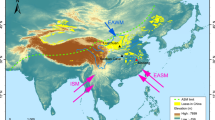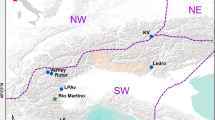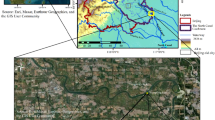Abstract
The 28-m high-resolution Shajinping loess section in Lanzhou on the Chinese western Loess Plateau records a detailed history of millennial Asian summer monsoon change since the earlier last glaciation. Summer monsoon proxies of soil magnetic susceptibility, carbonate content and soil color show that Asian summer monsoon experienced a series of rapid episodic pulse enhancements spanning only ca. 1–2 ka and have sub-Milankovitch cycles of progressive weakening in low frequency domain since ca. 60 kaBP. Soil formation responds to these by deepening colors, accumulating organic matter, increasing biological channels and leaching certain carbonates. The pedogenic degree generally increases with the degree of enhancement of summer monsoon. These may reflect the impact of the last glacial fast climatic change in the North Atlantic region on Asian summer monsoon.
Similar content being viewed by others
References
Dansgaard, W., Johnsen, S. J., Clausen, H. B.et al., Evidence for gencrnl instability of past climate from a 250 kyr icecore record,Nature, 1993, 364: 218.
Bond, G., Broecker, W., Johnsen, S.et al., Correlations between climate records from North Atlantic sediments and Greenland ice,Nature, 1993, 365: 143.
Heinrich, H., Origin nnd consequences of cyclic ice rafting in the Northeast Atlantic Ocean during the past 130 000 years,Quat. Res., 1988, 29: 142.
Porter, S. C., An Zhisheng, Correlation between climate events in the North Atlantic and China during the last glaciation,Nature, 1995, 375: 305.
Li, J.-J., Zhu, J.-J., Kuang, J.-C.et al., Comparison of Lanzhou loess section of last glacial epoch with Antarctic Vostok ice core,Sci. in China, Ser. B. 1990(10): 1086.
Tsukamoto, S., Infrared stimulated luminescence (IRSL) dating of Chinese loess deposits,Abst. An. Conf. Jap. Geogr. Soc., Tokyo: Tokyo Metropolitan University, 1997.
Martinson, D. G., Pisias, N. G., Hays, J. D.et al., Age dating and the orbital theory of the ice ages: development of a high-resolution 0 to 300 000-year chronostratigraphy,Quat. Res., 1987, 27: 1.
Linsley, B. K., Oxygenisotope record of sea level and climate variations in the Sulu Sea over the past 150 000 years,Nature, 1996, 380: 234.
Author information
Authors and Affiliations
About this article
Cite this article
Fang, X., Pan, B., Guan, D. et al. A 60 000-year loess-paleosol record of millennial-scale summer monsoon instability from Lanzhou, China. Chin.Sci.Bull. 44, 2264–2267 (1999). https://doi.org/10.1007/BF02885935
Received:
Issue Date:
DOI: https://doi.org/10.1007/BF02885935




